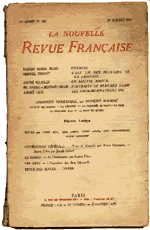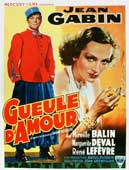![]()
André
Beucler
French
writer
1898 - 1985
A
look at
a life
(biographical milestones)
Second part

|
Second part |
 |
|
|
| 1925 - 1930 | The glorious years | In the centre of literary modernity | |
| 1929 - 1934 | The auspicious years | From cinema to major reporting | |
| 1934 - 1939 | Contemplation | Essayist and translator |
 |
In 1925 Andre Beucler creates a stir with his entry into the world of the Republique des Lettres. Gaston Gallimard takes him on under contract. In May, his first book is published: La Ville anonyme. In July, La Nouvelle Revue Française prints, alongside Rilke, Proust and Gide, his first short story: Un nouvel amour. In August, the Cahiers du mois publish a tale of fantasy: Entree du désordre. In October, the avant-garde collection, Cinario, presents early cinephiles with a yet unpublished synopsis: Un suicide. |
 |
|
These
four works were to attract attention immediately. Already in June,
Paul Morand had greeted the newcomer: "I haven't, for many years,
read an author with such satisfaction." In August, Max Jacob
wrote to him: "You are a new man: this is the highest praise
one can give an artist." |
|
"A lot of noise is being made, in certain circles, about this novel, and have I not read that it reveals considerable talent!" grumbles Firmin Droz, the Eclair's authoritarian critic. "I have often been reminded, during this demanding reading, of Rimbaud's Saison en enfer " confesses the no less severe serial writer, Pierre Bonardi, in Europe nouvelle. |
|
This is likewise the year in which Beucler cements indestructable friendships: Léon-Paul Fargue, Max Jacob, Jean Cocteau, Paul Morand, Joseph Kessel et Jean Giraudoux. He also joins the informal club, " Moins de trente ans " recently created by the artist, Pol Rab, which only includes members coopted unanimously. The only possible way to look at this learned assembly today is with awe: Joseph Kessel, Pierre Bost, Robert Desnos, Steve Passeur, Armand Salacrou, Marcel Achard, Georges Auric, Henri Jeanson, Jean Fayard, Pierre Lazareff, Emmanuel Bove, Marcel Aymé, Claude Aveline, Pierre-Jean Launay, Julien Duvivier, Carlo Rim... |
|
In this melting pot which describes the Paris of 1925, Beucler gives free rein to his driving fervour. Together with Fargue, he lives at night. For a long time with Max Jacob he will walk the music hall promenades, and in this field, not yet become common, he will be one of their best reporters. One of cinemas' first avant-garde critics too, he shows enthusiasm for Eisenstein and Charlie Chaplin. With Alfred Fabre-Luce he travels widely in Soviet Russia, giving conferences and bringing back reports. |
|
Yet he still takes time to continue his literary work and often isolates himself in his house near Montbeliard. In just two years he publishes ten or so short stories plus four novels, one of which is to gain considerable success: Gueule d'amour. |
 |
|
In 1926 Charlie Chaplin tells Maurice Martin du Gard, director of Les Nouvelles Litteraires at that time, of his temptation to transpose Gueule d'amour to the cinema because he finds that Beucler is "the best friend that chance has in France". |
|
|
|
|
Andre Beucler is always in pursuit of "even more". There
is no limit to his curiosity and appetites. But, in the early Thirties,
he finds himself suddenly married and a father. So he takes the opportunity
to reconcile adventure and security, by accepting, invited by Raoul
Ploquin, to become part of the French team in a powerful group whose
ambition it is to produce a European Cinema: the U. F. A. in Berlin.
He begins this experience by writing the dialogues and collaborating on the first film made in three versions with three distributions: German, English and French. This is to be IF1 ne repond plus, derived from the Siodmak novel and filmed in the Baltic Sea. For the French version the actors are Charles Boyer, Pierre Brasseur, Jean Murat and Daniele Parola. Although the gigantic production of IF1 ne repond plus, a veritable paradigm of James Bond type films, forms a step in the evolution of the arthouse film, the other films in which he participated made no mark on this cinema, but were a means of earning a good living. Through seven films, IF1 ne repond plus, Adieu les beaux jours, Tambour battant, Le Secret des Woronzeff, Princesse Czardas, Nitchevo et Bar du sud, Beucler was successively or simultaneously adapter, script-writer, screen-writer, co-producer. Once again, these occasions for collaboration developed into longstanding friendships: Charles Boyer, they had already met on the benches of the Sorbonne, Pierre Blanchar, Jean Gabin, Brigitte Helm, Lilian Harvey, Mireille Balin, Ginette Leclerc, Francoise Rosay, Meg Lemonnier, Lyne Clevers, Madeleine Ozeray... |
|
|
However, the cinema will enable this tireless man to combine the most useful with the most enjoyable and to maintain his connections with the press. Anxiety in the face of a stirring Germany, the evolution of the Russians for whom his fondness is hereditary, his attentive curiosity to the insoluble problems of Central Europe, all play an important part in making him one of the major press reporters particularly in the Gallimard magazine Marianne, created by his friend Emmanuel Berl, but also in l'Intransigeant, Candide or Paris-Soir. |
|
Jean Prevost proclaims that he is "one of the most sober, level-headed, penetrating journalists in his description of Hitler's Germany". Pierre Bost says he "tells of what he sees, knows how to see, likes to see fairly and possesses writing that is direct, dense, rich in striking turn of phrases; it seems ready-made for travel narration, is as picturesque as films and as rigorous as reports. "Maybe it is this overwhelming activity that made him neglect his romantic verbosity - on top of this it is said that he may have become consultant for political cabinets (in particular the Daladier cabinet). Faced with the rise of the Nazis, Beucler issues increasing warnings, unfortunately not heeded. It is precisely this activity that will force him to leave Germany precipitately, where he is considered undesirable from 1934 onwards, (he will figure on the infamous Abetz list). |
|
|
|
|
Frustrated in his huge appetite for life and work, in the midst of divorce, he returns to a less bubbling Paris. All the same, he comes back to old friends and a love of constructive strolling: Fargue, his lifelong friend, Kessel of course, but also Lucien Fabre, Matila Ghyka, Marie Laurencin, Louis Jouvet and even the elusive Giraudoux. |
|
Beucler
withdraws more often to his franc-comtois ivory tower in Bondeval
close to Montbeliard, where he works. Emmanuel Berl asked him to
write the first biographical study of Hitler for the Editions Nationales
recently created by Gustave Tronche (1937). He also translates a
new Russian epic poem written by a young writer about the Red Terror
in Siberia in 1919 (La Horde by Chichkov).
|
 |
He
does not participate in the adaptation of his novel Gueule d'amour
brought to the screen in 1937 by Jean Gremillon with Jean Gabin in
the main role. At this time he has at heart to complete a large,
complex, comprehensive novel, La fleur qui chante, his first look
back over the years. This colossal novel introducing real characters
under fictitious names came out at a very untimely moment: it could
hardly be noticed in September 1939 ! The war Beucler had felt inevitable
was declared.
|
|
|
|
|
|